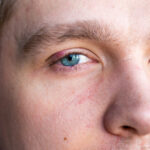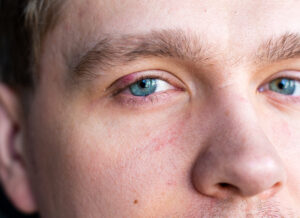
We have all been there in the last year – our sunglasses or eyeglasses fogging up due to mask wear. Many of us have also dealt with mask-induced acne and rosacea which has caused an uptick of dermatology visits. Now, we are seeing the repercussions of mask wear in the ophthalmology community.
Although vaccines are readily available and COVID-19 numbers have declined since 2020, there are still mask requirements and many unvaccinated individuals or patients with compromised immune systems have to be extra careful and continue mask-wearing.
It has been proven in a recent study published by the American Journal of Ophthalmology that “widespread mask wear does appear to correspond to an increased incidence of chalazion.”
What is a chalazion you may ask? For those of us who have had the pleasure of having one or more, they are lumps/bumps on your eyelid. When you wake up feeling and looking like a monster out of a Disney movie, many times, chalazions or “styes” are to blame.
In this blog article, we wanted to share what these are, the differences, potential treatments, and ways to avoid them!
What is a stye? A stye (also called a hordeolum) is a small, red, painful, sore lump near the edge of your eyelid. It usually grows from the base of your lashes or under your eyelids. Most of the time, these are caused by a bacterial infection.
There are two kinds of styes: External hordeolum which begin at the base of your eyelashes (most are caused by an infection in the hair follicle and may look much like a pimple) and Internal hordeolum which are styes inside your eyelids caused by an infection in an oil-producing gland in your eyelid.
It’s important to note that many people with blepharitis get frequent or recurrent styes – blepharitis is a condition which makes your eyelids pink, red and swollen (at the base of your lashes).
What does a stye feel like? Your eyelid is probably red and very tender to the touch when you have a stye, as they could be painful. A sore and scratchy feeling may also accompany your tender lids.

What is a chalazion? It is essentially a swollen lump or bump in the upper or lower eyelid which is caused by obstruction and inflammation of an oil-producing gland of the eyelid. When those oil glands get clogged up, they understandably get enlarged.
A chalazion may START as an internal hordeolum (or a “stye”) described above. Unlike the stye, in the beginning, you may not even know you have a chalazion as there is little or no pain.
However, as the chalazion grows, your eyelid may get red, swollen, and tender to touch at times. If the chalazion gets large, it can apply pressure on your eye and even cause your vision to become blurry; in some cases, your whole eyelid might swell.
What is the difference between a stye and a chalazion? It can be difficult to tell the difference between the two of these! What we can narrow it down to is pain level: A stye is usually very painful. It often presents itself at the edge of your eyelid and is usually caused by an infected eyelash root. Oftentimes it swells and can affect the entire eyelid.
Unlike a stye, a chalazion is not usually painful and develops farther back on the eyelid than a stye (not on the edge). It is caused by a clogged oil gland vs. an infection. It usually does not cause the entire eyelid to swell.
I have a chalazion or stye. WHAT DO I DO?
Here are some treatment Options for Styes and Chalazions:
- Warm compresses: The most common and easiest treatment option is to soak a clean washcloth in hot water and massage your eyelid 3–5 times a day. Doctors recommend patients do this for 10–15 minute intervals and consistently keep the cloth warm by soaking it in hot water regularly. Warm compresses with massages help the clogged oil gland to open up and drain.
- Antibiotics: Some ophthalmologists will prescribe an antibiotic for an infected stye.
- Steroid shots: Depending on the amount of swelling of the lid, your ophthalmologist may administer a cortisone shot (cortisone) in order to lessen that swelling.
- Surgery: If your chalazion or stye happens to affect your vision or just does not go away, you may need to have it professionally drained. This minimal surgery is typically done using local anesthesia in the ophthalmologist’s office.
- Biopsy for Recurrent Styes/Chalazions: If it keeps coming back time after time, your ophthalmologist may decide to remove your chalazion or stye for a biopsy. Your doctor will remove a very small piece of tissue and send it to the lab to be studied. The biopsy results will help determine whether there is a more serious eye problem.
WHAT NOT TO DO: Whatever you do, do not squeeze or try to pop your stye or chalazion like a pimple as you could potentially spread the infection into your eyelid. Also, make sure not to wear contact lenses or eye makeup while you have either a stye or chalazion.
According to the American Journal of Ophthalmology’s study – we can minimize the risk of chalazion while maintaining the protective benefits we get from wearing masks. To do so, we would need to take proactive measures to decrease mask induced eye dryness and changes in our eyelid microbiome.
The increased incidence of acne we have seen due to masks has been caused by localized increases in temperature and humidity, and similarly, since wearing a non-respirator face mask generally directs breath upwards to the periorbital area, it is now believed that wearing masks may also create just the right micro-environment for eyelid inflammation which would contribute to the development of a chalazion.
This study has been helpful in both identifying the cause of the increased incidence of chalazions and styes, and to offer some ideas to potentially prevent more.
How to Prevent a Chalazion:
- Avoid touching your face often
- Practice good hand hygiene often (wash your hands!)
- Try to avoid constantly adjusting your mask
- Wash your cloth face mask frequently with HOT water
- Place adhesive tape on the bridge of the nose of your mask to minimize the air that you breath upwards into your eyes
- Use an eyelid scrub as part of daily lid hygiene regimen: this may act as both an antiviral and antibacterial blepharitis deterrent (Ask your eye doctor for the right scrub!)
The doctors at Slade & Baker Vision are happy to see you if you have either a stye or a chalazion. Please call us at 713-626-5544 or send us an email at info@visiontexas.com in order to schedule an appointment with our specialists!





